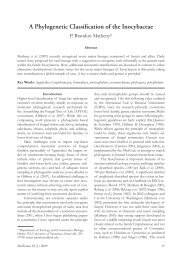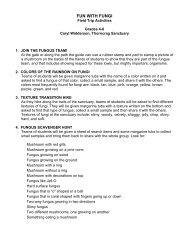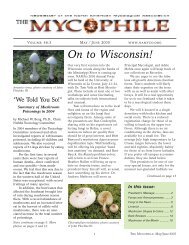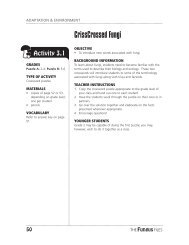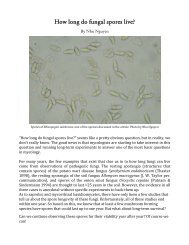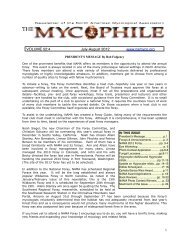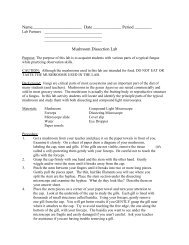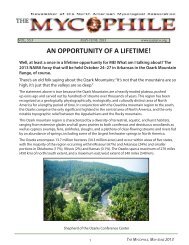McIlvainea - North American Mycological Association
McIlvainea - North American Mycological Association
McIlvainea - North American Mycological Association
You also want an ePaper? Increase the reach of your titles
YUMPU automatically turns print PDFs into web optimized ePapers that Google loves.
spores. A very similar one is Galerina marginata.<br />
Th at one is more common in Europe. Th e main<br />
diff erence lies in the non-sticky cap of this species.<br />
It is best observed by gently breaking a cap<br />
in half and slowly separating the two parts. In the<br />
case of G. autumnalis a thin sticky fi lm (pellicle)<br />
will be visible.<br />
But this summer, I found some other Galerinas,<br />
also brown and with a ring, but smaller<br />
and more slender. And they were not growing<br />
on wood, but in between hair-cap moss (Polytrichum)<br />
on dry sandy soil. Th e name I came up<br />
with was Galerina unicolor. Th e strange thing is<br />
the way the description of its habitat seems to<br />
have changed over time. For example, Moser,<br />
1952: growing on wood; Pomerleau, 1980: on<br />
stumps and wood debris; Moser, 1978: on rotten<br />
wood, rarely between mosses along brooks; Bon<br />
1987: found in wet meadows; Hansen & Knudsen,<br />
1992: among grass, herbs, mosses, not in<br />
particularly moist places. Th ere you are. Th at last<br />
description fi ts my species pretty well. But, as you<br />
can see, this species seems to have changed from<br />
a habit of growing on wood, to one on wet soil to<br />
one on dry soil. Th e original description is very<br />
old and came from Vahl (this could be an abbreviation).<br />
Later on, this species was entered by E.<br />
Fries in his Systema Mycologicum, but that was in<br />
1821! Now I’m just wondering if the mushroom<br />
itself evolved or if the mycologists changed their<br />
minds. What do you think?<br />
Volume 17, Number 1, Spring 2007 11<br />
Galerina<br />
dicranorum<br />
on Dicranum<br />
scoparium<br />
AD11, 1999/2, Moss and<br />
LBMs Go Well Together<br />
Everybody notices red Russulas<br />
among green moss, but small<br />
brown mushrooms, in moss<br />
or otherwise, are usually overlooked.<br />
LBMs, as Little Brown<br />
Mushrooms are collectively<br />
called, can however also look<br />
quite decorative, especially in<br />
moss. One large group of LBMs<br />
belongs to the Galerina clan.<br />
Th ey can look very elegant with<br />
their tiny bell-shaped caps on<br />
long slender stems. Instead of<br />
Little Brown or Boring Mushrooms,<br />
you might even call<br />
them Little Brown Marvels, to<br />
quote a much friendlier name<br />
used by John Neville in his<br />
LBM article (<strong>McIlvainea</strong>, vol. 12, no. 2, 1996).<br />
True, they can be frustratingly diffi cult to<br />
identify. But although being small they nevertheless<br />
have a number of clear distinctive features,<br />
unfortunately mostly microscopic ones. Th e<br />
spores are surprisingly large and come in diff erent<br />
styles and sizes. Th ey can be smooth or ornamented,<br />
with or without a pore, with or without<br />
a plage (a smooth area near the base of the spore)<br />
and sometimes have a calyptra (a loose-fi tting<br />
“hood” over part of the spore). Th ere is also a nice<br />
selection of cystidia available. Most of the species<br />
grow in wooded areas, on wood, soil, plant<br />
debris or humus and quite a number prefer moss.<br />
Th ese are sometimes named after the mosses they<br />
are found with, e.g. Galerina leucobryum (on<br />
Leucobryum moss), G. mniophila (on Mnium),<br />
G. sphagnicola (on Sphagnum), G. hypnorum (on<br />
Hypnum), and G. dicranorum (on Dicranum).<br />
At the Jack Parkin Memorial Foray last fall<br />
we did encounter some Galerinas. One was associated<br />
with Dicranum scoparium or Broom<br />
Moss (scopa=broom). Th is is a common moss<br />
around here and is easy to recognize. Th e stems<br />
are upright and the leaves are bent in one direction,<br />
like they are windswept. Th e name Broom<br />
Moss is apt because they remind one of an old<br />
fashioned broom made of birch twigs. Th e fact<br />
that this Galerina did grow on Broom Moss does<br />
not necessarily make it into a G. dicranorum.



